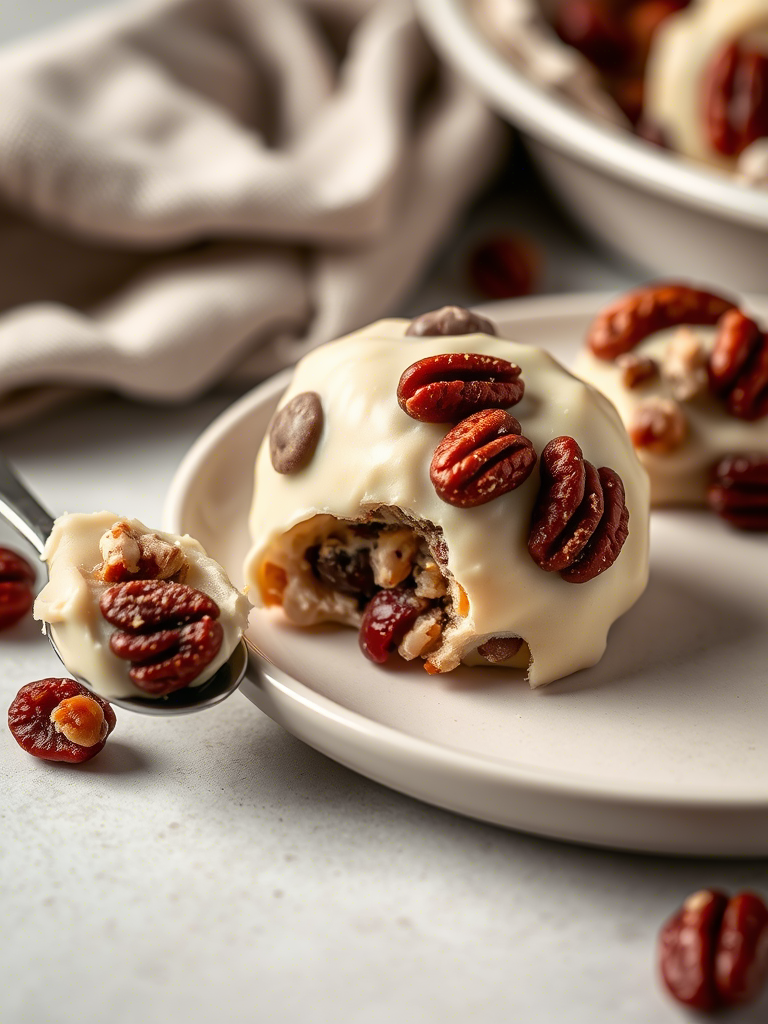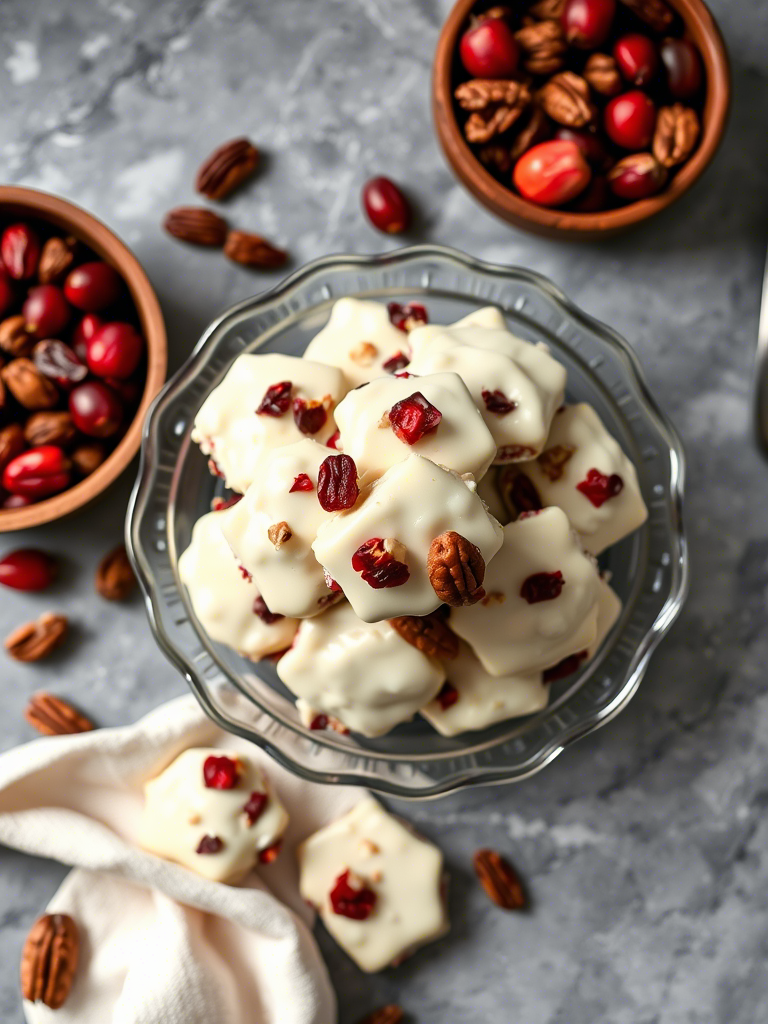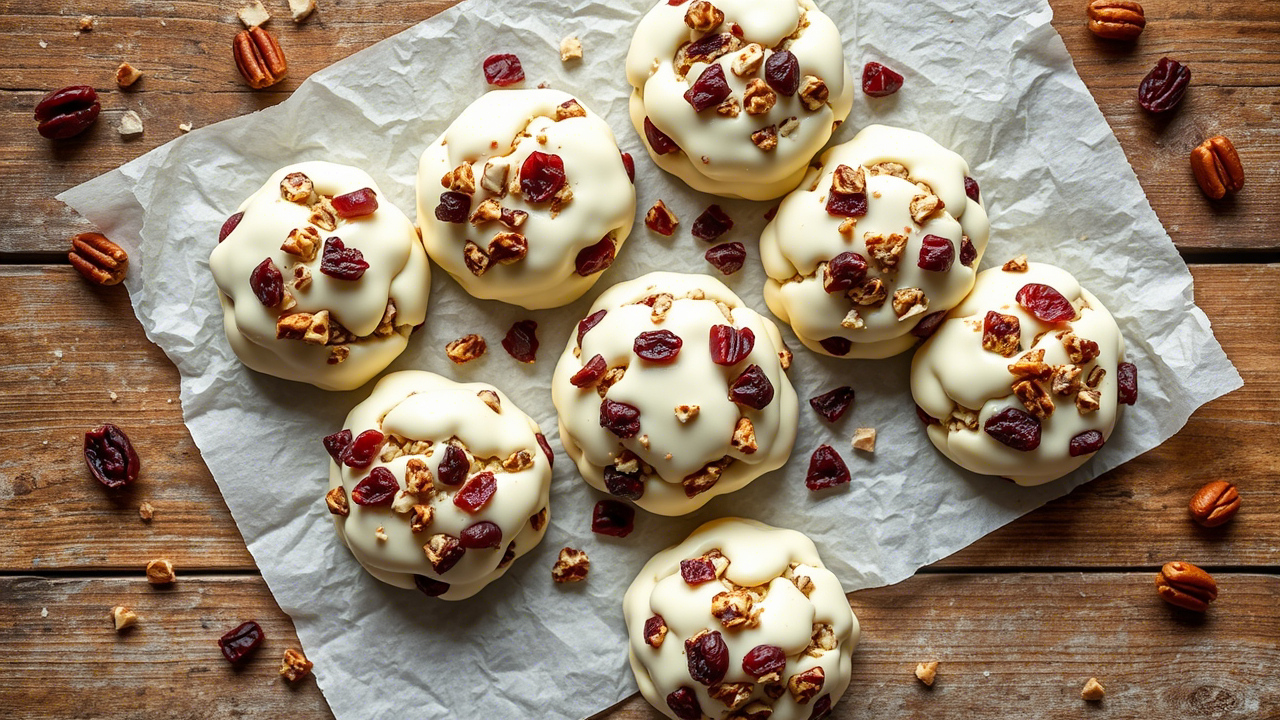Ever taste something so stupidly simple, it’s like, how did I not make this before? That’s the kind of magic we’re dealing with here. White Chocolate Cranberry Pecan Clusters—a mouthful of a name for something you could practically throw together blindfolded, yet still, they carry enough culinary swagger to stand proudly on a dessert tray next to your three-day-aged truffles. This ain’t your average “holiday treat.” This is texture, contrast, and flavor theory—crammed into bite-sized brilliance.
We’re not just tossing some ingredients together. We’re dissecting why these work, how they hit the right notes, and what not to do so they don’t flop into sticky little blobs. This is for the pros, the serious home cooks, and anyone who knows the difference between couverture and compound.
Let’s dig in.
The Science of the Cluster
So here’s the thing. Clusters work because they’re chaotic—but balanced. There’s no smoothing out of flavors. Each element pops.
White chocolate, with its high sugar and milk solids, brings the creamy sweetness. But on its own? Too flat. Enter tart dried cranberries—those puckery little jewels that slice right through the fat. And then the pecans—crunchy, buttery, a little earthy—like if texture had a flavor.
It’s not random. It’s architecture.
White chocolate (if you’re using real white chocolate—not candy melts masquerading as such) contains cocoa butter, not cocoa solids. That makes it temperamental. Literally. Melt it too fast, it seizes. Introduce water, it splits. But treat it right, and you get a glossy finish and that delicate snap.
Cranberries bring not just tartness but chew. Pecans? Texture, sure, but also a toasty depth when roasted. This is culinary equilibrium. This is a study in contrast done right.
Ingredient Quality: The Gamechanger
Let’s not sugarcoat it—bad white chocolate ruins this. You need at least 30% cocoa butter. Brands like Valrhona Ivoire, Callebaut W2, or Guittard white chips? Those’ll do the trick.
Avoid coatings labeled “white chocolate flavored.” That’s code for “hydrogenated oil sugar brick.” If you’re working professionally, there’s no excuse to use them.
Pecans: raw vs. roasted? Roasted, every damn time. Dry-roasted pecans bring out that nutty flavor like nobody’s business. Roast ‘em yourself if you want full control. 325°F, 7–10 minutes, shake halfway through. You’ll smell it when they’re ready—nutty, warm, slightly sweet.
Dried Cranberries: unsweetened if you can find ‘em. But let’s be honest, most commercial cranberries are sweetened. Just check they’re not candied to death. Trader Joe’s makes a good one. Or better yet, soak them for 10 mins in warm orange juice or even Grand Marnier for a tiny flavor flex.

Method Matters: Technique Over Tossing
This ain’t just dump and stir. Well, it can be, but don’t. Here’s how you do it proper:
- Temper Your Chocolate (if pro): Not required, but if you want the glossy finish and room-temp stability, tempering is key. Bring ⅔ of your white chocolate to 110°F, then stir in the remaining ⅓ to cool to 83°F, then gently reheat to 87°F.
- Mix-in Ratio: Aim for 1:1 chocolate to mix-ins by weight. Yes, weight. Volume lies. You want every bite to have contrast, not a gob of chocolate with a lonely cranberry.
- Pre-toast the Pecans: Never skip this. It’s a non-negotiable if you want that rich, roasted pecan flavor to stand out.
- Cool Fast, But Not Frozen: Set clusters on parchment-lined trays and let ‘em set at room temp (ideal if tempered). In a pinch, the fridge works, but you’ll risk sugar bloom—those whitish streaks that make your treats look like they’ve been left out in the fog.
Flavor Upgrades (for When You’re Bored of Basic)
Feeling fancy? Add a pinch of Maldon sea salt on top just as they’re setting. That salt sings on the white chocolate.
Craving warmth? Try ground cardamom in the mix—just a whisper. ⅛ teaspoon max. It pairs outrageously well with white chocolate and cranberries.
Wanting that holiday edge? Add finely grated orange zest—just a bit—into the mix. Make sure it’s zest, not pith. Pith is bitterness in disguise.
Feeling boozy? Soak those cranberries in dark rum or cherry brandy. Let them sit 20 minutes, then drain and pat dry like they owe you money. No one wants soggy clusters.
Shelf Life & Storage—And Why Most Folks Mess This Up
Because these have nuts and dried fruit, moisture control’s crucial. Store in an airtight container at cool room temp (ideally 65–70°F). Skip the fridge unless your kitchen is a sauna.
Properly stored, they’ll last up to 2 weeks. But good luck making ‘em last that long.
Important note: do not freeze. Ever tried freezing white chocolate? It gets chalky, the texture breaks, and you’re left with sweet sadness.
If you’re packaging for sale or gifting, layer with parchment or wax paper between stacks. These stick like toddlers to knees otherwise.
Common Mistakes Pros Still Make
1. Using the wrong chocolate. We’ve said it already, but it bears repeating—quality white chocolate is the spine of this dessert. If it’s waxy, greasy, or overly sweet, everything else falls apart.
2. Not measuring by weight. Cups lie. A cup of chopped pecans isn’t the same as a cup of whole ones. Get a scale. They’re cheap. They’re gospel.
3. Skipping the toasting. Raw pecans taste like the ghost of flavor. Toasting activates the oils and caramelizes the natural sugars. It’s like turning the lights on.
4. Overcrowding the tray. Give them space. They spread slightly. They’re not clingy cookies.
5. Not cooling completely before storing. You lock in condensation, it turns sticky. You don’t want your clusters to feel like humid marshmallows.
Market & Menu Application
If you’re in foodservice, these clusters can be absolute gold. Quick prep, high profit margin, easy to scale.
Use them in:
- Gift baskets
- Coffee shop counter jars
- Plated desserts as texture garnish
- Holiday specials with flavor variations (pistachio-apricot, cherry-almond, etc.)
Want to stand out? Use custom molds or silicone mini muffin trays for uniform shape. Or go rustic and hand-drop with a spoon—people weirdly love the “homemade look.”
Cost per cluster can be under $0.40, depending on your ingredient source. You can retail them for $1.50–$3.00. That’s good ROI, and they practically sell themselves when people get a sample.

Emerging Trend: Clean Label Variations
Clean label snacking is on the rise—especially in the dessert sector. Shoppers are looking for recognizable ingredients. No artificial flavors. No preservatives.
Here’s how to keep it clean:
- Use organic cranberries, unsulphured.
- Source fair-trade white chocolate.
- Toast your own nuts.
- Skip any added flavor oils or synthetic flavorings.
Brands like Hu or Evolved are pushing clean, paleo-friendly chocolate snacks with this exact format. The difference? They’re charging $8 for a 4-ounce pouch. You can do better, both in quality and price.
Nutrition Notes for the Curious (and Cautious)
Let’s not pretend these are health food. They’re candy adjacent. But compared to cookies or truffles, they’re not terrible.
Here’s a rough nutrition estimate per 1.25 oz cluster (about 35g):
- Calories: 190
- Fat: 13g
- Sugar: 12g
- Protein: 2g
- Fiber: 1.5g
You can reduce the sugar slightly by swapping to low-sugar cranberries or using a stevia-sweetened white chocolate (though flavor suffers a bit). But again—this is dessert, not a granola bar.
Final Thoughts: Why This Treat Deserves More Respect
It’s easy to dismiss clusters. They seem too easy. Too quaint. But that’s the whole point. They’re culinary sleight-of-hand—sophistication disguised as simplicity.
When done right, White Chocolate Cranberry Pecan Clusters aren’t just another holiday sweet. They’re proof that you don’t need a complicated mise en place or three pages of ingredients to make something craveable, elegant, and deeply satisfying.
Whether you’re a pastry chef looking to add a quickfire option to your menu, or a home baker trying to impress guests without breaking a sweat, this is your golden ticket.
Make ‘em. Eat ‘em. Tweak ‘em. Just don’t underestimate ‘em.
They’re small. But they slap.
FAQs
What kind of white chocolate is best for clusters?
Use high-quality white chocolate with at least 30% cocoa butter, like Valrhona or Callebaut.
Can I use raw pecans instead of roasted?
You can, but roasting enhances the flavor and gives a better crunch.
Do I need to temper the white chocolate?
Tempering isn’t required but gives a glossier look and better shelf stability.
Can I substitute the cranberries with other dried fruit?
Yes, dried cherries, apricots, or blueberries work great too.
How do I store the clusters?
Keep them in an airtight container at cool room temperature for up to 2 weeks.
Can I freeze the clusters?
No, freezing ruins the texture and appearance of white chocolate.
How long do the clusters take to set?
Tempered chocolate sets in 20–30 minutes; untempered may take up to an hour.
What’s the ideal chocolate-to-mix ratio?
Use a 1:1 ratio by weight for balanced flavor and texture.
Are these clusters suitable for clean-label snacking?
Yes, if you use organic, fair-trade, and minimally processed ingredients.
How profitable are these for foodservice?
Very—low cost per piece and high resale value make them ideal for cafes and shops.
Can I make these vegan?
Yes, use dairy-free white chocolate and ensure your cranberries are vegan-certified.
Why did my white chocolate seize or clump?
It was overheated or exposed to moisture—white chocolate is very sensitive.
Can I add spices or zest to the clusters?
Absolutely—try orange zest, cardamom, or sea salt for flavor elevation.
Why are my clusters sticky after storing?
You likely stored them before they fully cooled or in a humid environment.

Mariana is a passionate home cook who creates delicious, easy-to-follow recipes for busy people. From energizing breakfasts to satisfying dinners and indulgent desserts, her dishes are designed to fuel both your body and hustle.
When she’s not in the kitchen, she’s exploring new flavors and dreaming up her next recipe to share with the Foodie Hustle community.

